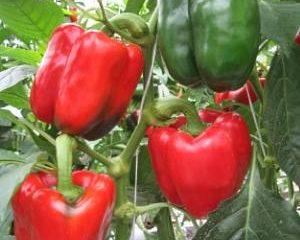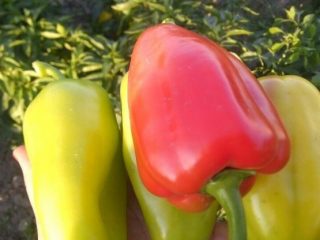Content
Agapovsky pepper is a proven variety of crop that most vegetable growers know and love. It is quite popular and widespread in many Russian regions due to the excellent quality of the fruit with relatively simple care. The plant is grown both for personal purposes and on an industrial scale.

Red sweet Agapovsky pepper is considered a mid-season variety
History of appearance
Agapovsky pepper appeared more than two decades ago. Work on its breeding was carried out by breeders from the All-Russian Scientific Research Institute SSOC. The variety is zoned in the Moscow region, suitable for growing in unprotected soil. It was entered into the State Register in 1995.
Description of pepper variety Agapovsky
Compared to other sweet peppers, Agapovsky looks more advantageous.Its strong bushes are literally strewn with beautiful, smooth, fragrant fruits. They have a high taste rating, are lightly fibrous, and the stalk is slightly depressed.
The dimensions of the bush allow you to cultivate the plant in a greenhouse and in open areas. The method is chosen depending on the location of the growing region.
Weight, color and shape of fruits
Agapovsky has an attractive presentation. The fruits are large, elongated prismatic in shape, about 16 cm in length. The average weight is 100-150 g, but with careful care it can reach 0.4 kg. The vegetable is thick-walled, fleshy, smooth with slight waves, the pulp is juicy, its thickness depends on the size of the fruit, sometimes reaching 1 cm. There are three to four seed nests. The color of peppers when ripe is bright red, green at the stage of technical ripeness, and the taste is sweet.

At the stage of biological maturity, you can collect Agapovsky pepper seeds for future sowing
Height and bushiness
The bushes of the variety are compact and of medium size. Their height does not exceed one meter and is approximately 80 cm, which allows the crop to be grown under arches to simplify care. The plant is heavily leafy, the leaf blades are large and dark green in color. The fruits on the bushes are arranged droopingly and evenly.
Characteristics of Agapovsky pepper
Despite the fact that there are currently many hybrids of sweet peppers, many of them are inferior in characteristics to the Agapovsky variety. It has not only excellent taste, but also high yield, early ripening, and good resistance to diseases and pests.
The product is universal, used not only fresh, but also suitable for preparing preparations for the winter.
Agapovsky pepper yield
One of the main positive characteristics of the variety is its high yield. A square meter of planting can produce up to 10 kg of ripe fruit. When growing Agapovsky pepper in a greenhouse, the yield is even higher and the fruiting period is longer.

Thanks to a good harvest on a small area, the variety is profitable to use for commercial production
Fruiting dates
Pepper variety Agapovsky is considered an early ripening variety. The fruits begin to ripen 100-120 days after emergence. About 140 days should pass until the state of biological ripeness.
Towards the end of July, when the length of the fruits reaches 8 cm, they can already be picked. In warm conditions they ripen freely in 15-25 days.
Disease resistance
Agapovsky is a pepper variety that has good resistance to most diseases. Immune to the most dangerous disease of nightshades - mosaic. Sometimes it can be affected by blossom end rot.
As for pests, the variety is unattractive to the Colorado potato beetle, but sometimes attracts interest from cotton jays, nematodes, aphids and whiteflies.
Growing regions
Despite the fact that Agapovsky pepper bushes are resistant to changes in humidity and temperature, it is recommended to grow it only in the second and third light zones. They include regions from Leningrad to Vologda and from Belgorod to Kursk. Also on the list of regions acceptable for plant cultivation are Yakutia and Khakassia.
Advantages and disadvantages
For many years, Agapovsky pepper has occupied a leading position in the ranking of this variety of vegetable crop.The variety has a large number of advantages and only some disadvantages.

Ease of care and unpretentiousness allows even inexperienced gardeners to grow crops
Advantages:
- high yield rates;
- early ripening;
- good immunity to diseases;
- excellent presentation;
- taste qualities;
- versatility in use;
- compact dimensions;
- unpretentiousness.
Flaws:
- need for regular watering;
- susceptibility to blossom end rot;
- lighting requirements.
Recommendations for cultivation
Maximum crop yield can be achieved with careful adherence to agricultural technology. Among the features of growing Agapovsky pepper, several facts should be highlighted:
- the plant requires garter and support;
- shows the best results indoors;
- requires removal of the flower in the first branch of the shoot;
- needs timely harvesting.
When and how to plant seedlings
Agapovsky pepper is grown in seedlings. Seeds begin to be sown in late February until the second half of March. They must be pre-treated with potassium permanganate. The soil is taken to be porous, with a sufficient content of humus or peat. After sowing, the boxes are covered with film or glass. 15-20 days after the sprouts appear, Agapovsky pepper seedlings are planted in separate containers and provided with comfortable conditions - daytime temperatures within +20-24 °C, night temperatures around +17 °C. When the ground is warmed up to +15 °C, young plants can be planted in closed ground.

Agapovka pepper does not produce long shoots and needs to be picked once
Transplantation into open ground
If the variety begins to be planted in the greenhouse in the middle or towards the end of April, then the moment when Agapovsky pepper can be moved to unprotected soil comes in early May.
Before planting, the soil is first shed with a solution based on copper sulfate to prevent fungal diseases. No more than three pepper bushes are planted per square meter with a minimum interval of 40 cm. After replanting, the beds are mulched with straw or peat.
Aftercare
Caring for the crop is not difficult. For a good result, you should follow several rules:
- Carry out regular watering. The soil should be moistened as soon as it is completely dry. Usually two irrigations per week are enough, since Agapovsky pepper does not like waterlogging.
- Loosen and weed the beds. It is advisable to carry out the procedure after each watering.
- Mulch the soil. As a material, it is better to give preference to straw, hay, sawdust.
- Apply fertilizers. Fertilizing begins three weeks after planting the seedlings - with ammonia additives and at the flowering stage - with organic and potassium compounds, and ash.

Agapovsky pepper is suitable for all types of culinary preparations
Prevention of diseases and pests
Due to its high immunity, the variety does not require preventive spraying.But in order to protect the beds as much as possible, gardeners try to adhere to the following rules:
- remove weeds in a timely manner;
- do not thicken plantings;
- treat seeds before planting;
- Ensure good ventilation in the greenhouse.
To protect peppers from pests, you can treat the beds with tobacco dust, infusion of garlic or wormwood, and wood ash.
Conclusion
Agapovsky pepper is a wonderful productive variety that has earned a lot of positive feedback from gardeners and farmers. It is easy to care for and does not need to be treated for diseases. The fruits ripen are tasty, juicy, beautiful, with a high content of vitamins and nutrients.
Reviews from gardeners about Agapovsky bell pepper








